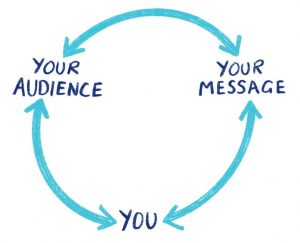The Holy Trinity of Public Speaking
– The 3 Elements all Great Speeches and Presentations Must Have
Recently I was working with a senior advertising executive, whom I’ll call Linda. Normally a pretty confident speaker, Linda feared that because many of the people she would be addressing in a big client presentation were not from the advertising or marketing team they would not be interested in what she had to say.
I loved the fact that she was already thinking about her audience and what they needed to hear. As the maxim goes:
It’s not what you say that’s important; it’s what the audience hears.
You can have the most illuminating and inspiring speech ever written, but if the audience in front of you isn’t getting it, you may as well read an IKEA assembly instruction manual to a cat.
So how could Linda make the presentation something that her audience could relate to?
I asked Linda what the talk was about. “Previous performance and future success of the brand,” she said without enthusiasm. What is important about what the client does? I asked. She gave me a few more answers which included jargon words like market share, augmenting brand value and customer segment breakthrough. It sounded less than compelling, and she knew it.
She needed to feel connected to what she was talking about. Very often, it’s the story behind the story that provides the spark. We needed to identify where the motivation comes from. We dug a little deeper and suddenly her eyes lit up: “They give customers the chance to enjoy a treat.” From that moment she understood how she could communicate the motivation of her client. She understood what would be true for every single one of the client personnel at the meeting. Seen in that context, the plans she had to present would make more sense. She had identified two of the three key elements her talk needed: she had found a resonance that connected her audience to her message.
But she was missing one ingredient: herself. Why was she talking? What was her skin in the game?
She told me a story about going to one of her client’s stores in the holidays with her young son. Her son, who normally hates any kind of shopping, immediately found something he loved. A shopping expedition that started as a chore turned into a treat; it was the perfect embodiment of what her client stood for. And Linda, quite brilliantly, had found a way to connect herself, her audience and her message.

Another great example of this in action is Obama’s speech at the 2004 Democratic Party Convention, one of all time my favourite speeches. In it, he connected his own story to the wider American story, and to his message that America represents hope for everyone. This allowed the audience in the convention, and the millions watching around the world, to identify with him and his message. It launched him as a political force, and he wouldn’t have become president without it. He achieved this in just one speech in which he connected himself, the audience and his message.
Imagine what you could achieve in your next presentation if you connect yourself, the audience and your message.
